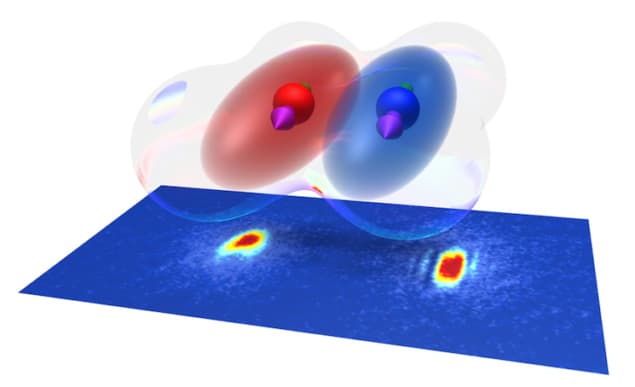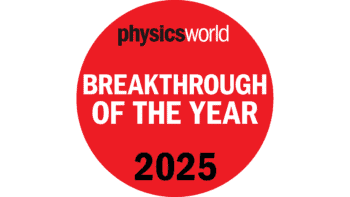
Researchers at the Institute for Quantum Optics and Quantum Information in Austria have succeeded in creating the first ever dipolar quantum mixture in which Bose-Einstein condensates made of two different highly magnetic species coexist and interact with each other over a long range. The condensates, made of erbium and dysprosium, might be used to study the quantum behaviour of ultracold gases (such as fermionic superfluids) in more detail as well as to create novel states of matter containing many-body quantum states.
A Bose-Einstein condensate (BEC) is an exotic state of matter and is produced when a gas of atoms is cooled (in an optical trap) until the de Broglie wavelength of the atoms becomes comparable to the distance between them. The atoms then collapse into the same quantum ground state and can therefore be described by the same wavefunction. The phenomenon was predicted nearly a century ago by Albert Einstein and Satyendra Nath Bose, and researchers created the first such condensate in 1995 with rubidium atoms – work that earned them the Nobel prize in Physics.
“So far, most BECs have been created with such alkali atoms,” explains IQOQI team leader Francesca Ferlaino. “These are relatively simple atomic species in the sense that their quantized energy spectra only have a few ‘lines’. At ultralow temperatures, alkali atoms interact with each other via a force that extends over a very short range.
“In contrast, the rare-earth magnetic atoms we studied, erbium (Er) and dysprosium (Dy), have very rich energy spectra with many different lines. It is for this reason that researchers believed that it might be difficult to cool these many-valence-electron atoms down to the temperatures required.”
“We have now shown that the complexity of atomic physics can open up new possibilities and have merged the physics of heteronuclear mixtures with that of magnetic dipolar quantum gases for the first time to create a new dipolar quantum mixture.”
Two-species laser- and evaporative cooling
Combining the two species was no easy task, however, she says, and required simultaneous laser- and evaporative cooling. In previous work, published earlier this year in Physical Review A 10.1103/PhysRevA.97.023633, Ferlaino and colleagues developed an efficient way to laser cool both Er and Dy atoms at the same time down to 10 μK using a novel five-laser-beam technique that combines lasers and magnetic fields. In the new work, they now trap the Er and Dy atomic clouds produced in this way in a high-power infrared beam and then selectively evaporate the hottest erbium atoms. The dysprosium atoms become colder thanks to this process, allowing temperatures of about 100 nK to be attained for both species.
“The magnetic field in this experiment is extremely important since the atomic scattering and loss processes in the mixture depend very strongly on this field,” explains Ferlaino. “We also used traps whose shape and depth we could tune so that the more weakly trapped Er would evaporate more easily than Dy and thus serve as the coolant for the Dy.”

Different isotopes
The researchers studied different isotopes of Dy and Er and produced dipolar Bose-Bose mixtures with five different isotope combinations, as well as one Bose-Fermi mixture. They observed clear evidence for strong repulsive interactions between the species in one isotope mixture (166Er and 164Dy).
“The Er-Dy mixture is unique in that both species strongly interact with each other over a long range, as do both condensates,” Ferlaino tells Physics World. “This is a rather unexplored area for quantum matter and we do not yet know which novel phases of matter we might be able to access and realize.”

Ultracold atoms quench a thirst for universality far from equilibrium
“Imagine a fluid made of gas-phase atoms, something that is, in itself, counter-intuitive, in which particles can spontaneously form special geometrical patterns to minimize their energy,” she continues. “Now mix two of those patterns and bring the ensemble into the quantum regime in which correlations between the particles dramatically increases. It is not yet clear whether these two dipolar-quantum fluids will be miscible, how the mixture will re-organize and which novel states will be established.”
The researchers, reporting their work in Physical Review Letters 10.1103/PhysRevLett.121.213601, say they are now busy developing a microscope able to directly observe the atoms in the condensates with a high resolution while they are still trapped. “We will also be studying how the magnetic field affects the scattering properties of the atoms so that we can change the interaction between them. This is a key parameter for all further studies.”



